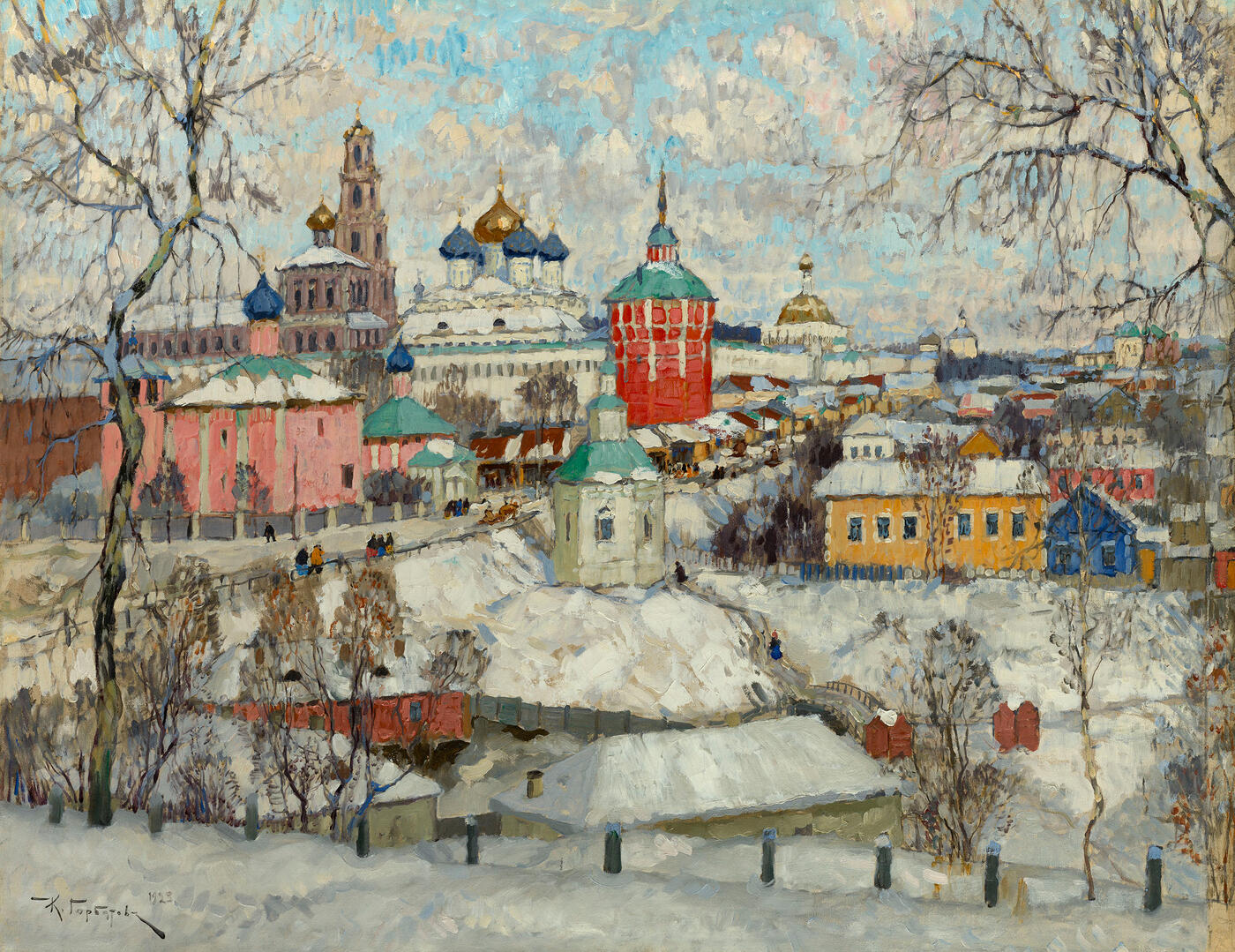28 Nov 2018 Important Russian Art Auctions, at Asia House
28 November 2018

20. GORBATOV, KONSTANTIN (1876–1945)
Trinity Lavra of St Sergius in Winter, signed and dated 1923.
Oil on canvas, 85.5 by 109.5 cm.
120,000-180,000 GBP
Provenance: Russian Art, Sotheby’s New York, 16 April 2008, lot 53.
Acquired at the above sale by the present owner.
Private collection, Europe.
Authenticity of the work has been confirmed by the expert V. Petrov.
Exhibited: Les artistes russes hors frontière, Musée du Montparnasse, Paris, 21 July–31 October 2010.
Literature: Exhibition catalogue, A. Hofmann, V. Hofmann, G. Khatsenkov, Les artistes russes hors frontière, Paris, Edition Paradox, 2010, p. 118, illustrated.
The view of the snow-bound Trinity Lavra of St Sergius is among the most recognisable and best-loved pictures in Konstantin Gorbatov’s oeuvre. The artist’s legacy contains many depictions of the monastery, which is one of Russia’s most important spiritual centres, as well as landscapes featuring Sergiyev Posad and its environs. However, the 1923 panorama Trinity Lavra of St Sergius in Winter, now offered for auction, is one of the most successful compositions in this series.
Historic Russian cities became the artist’s main subject after he had returned from Italy in 1913. He managed to brilliantly adapt his painterly style, which had taken on its distinctive shape in sunny Italy, and his bright, fresh “Mediterranean” palette to the painting of the rather different features of his homeland. Gorbatov’s views of ancient Pskov, Vologda and Novgorod quickly earned him acclaim of an artist celebrating the “Old Russia” (G. Gaevsky, “Russkie shkoly zhivopisi”, in Rossiia v eio proshlom i nastoiashchem, Moscow, 1914), and enabled him to embrace the artistic principles of the Union of Russian Artists. It was around that time, in the 1910s, that the first views of the Trinity Lavra of St Sergius appeared, painted with free, dynamic brushstrokes. From then onwards, the image of the “heart of Russian Orthodoxy” remained for many years one of the most important iconographic motifs in Gorbatov’s work.
In Trinity Lavra of St Sergius in Winter, the artist creates a striking image that combines a realistic portrayal of the monastery with a romantically exalted generic vision of Old Russian architecture rendered within a wintry countryside. Despite the overall decorative approach, Gorbatov reproduces the topography of the monastery with high accuracy, correctly positioning the Lavra’s main buildings — the Church of St Paraskeva Pyatnitsa and the Church of the Presentation, the refectory with the Church of St Sergius of Radonezh, the Cathedral of the Assumption, the belfry and the Church of the Nativity of St John the Baptist. However, the resulting composition is much more than a mere panorama of the monastery’s walls and churches. Gorbatov allocates a substantial space in the foreground to the snowy slopes of the river Konchura, frames the composition with the birch trees, and enlivens it with the ragged white clouds covering a lofty expanse of sky and the small yet vivid staffage figures of local people or pilgrims making their way along the paths.
Painted in an unrestrained manner with sweeping, soft brushstrokes, the present composition stands out for its freshness of colour, characteristic of the artist’s best canvasses, an overall thrilling colouristic approach and an exquisite, sensitive rendering of light and air. It is undoubtedly a work that deserves to be in the best collections of Russian art.
Notes on symbols:
* Indicates 5% Import Duty Charge applies.
Ω Indicates 20% Import Duty Charge applies.
§ Indicates Artist's Resale Right applies.
† Indicates Standard VAT scheme applies, and the rate of 20% VAT will be charged on both hammer price and premium.